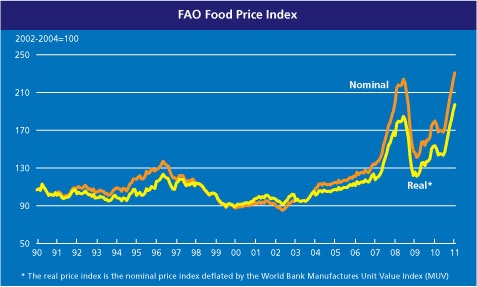
Waste and production are exasperating efforts to meet food needs. Oxfam also indicated that prices are expected to double over next two decades, at a time when a billion people go hungry and in many nations even the working poor are spending a majority or most of their income to feed their families.
World Bank & FAO Estimate Losses to Waste
The UN’s FAO (Food and Agriculture Organization) called for investing in post-harvest technologies to reduce to the losses and boost the continent’s food security. Large amounts of food in sub-Saharan Africa goes to waste as a result of inappropriate storage, (From UN News Centre) The joint FAO-World Bank report, entitled Missing Food: The Case of Postharvest Grain Losses in Sub-Saharan Africa, estimates the value of grain losses in sub-Saharan Africa at around $4 billion a year. Maria Helena Semedo, the FAO Assistant Director-General said:
“This lost food could meet the minimum annual food requirements of at least 48 million people, If we agree that sustainable agricultural systems need to be developed to feed 9 billion people by 2050, addressing waste across the entire food chain must be a critical pillar of future national food strategies,”
According to estimates provided by the African Postharvest Losses Information System, physical grain losses prior to processing can range from 10 to 20 per cent of African annual production, which is worth $27 billion. Losses occur when grain decays or is infested by pests, fungi or microbes, and physical losses, but the waste can also be economic, resulting from low prices and lack of access to markets for poor quality or contaminated grain.
According to the report, food losses contribute to high food prices by removing part of the food supply from the market. They also have a negative environmental impact as land, water and resources such as fertilizer and energy are used to produce, process, handle and transport food that no one consumes. “Reducing food losses is increasingly recognized as part of an integrated approach to realizing agriculture’s full potential, along with making effective use of today’s crops, improving productivity on existing farmland, and sustainably bringing additional acreage into production,” said Jamal Saghir, the Director of the Sustainable Development Department of the World Bank’s Africa Region.
Applying New Technologies to Safeguard Food
A variety of practices and technologies are available for reducing post-harvest losses, including crop “protectants” and storage containers such as hermetically sealed bags and metallic silos, the report notes. Those technologies have proved successful in Asia, but more research is needed to identify methods adapted to local environments in Africa. To succeed, interventions must be sensitive to local conditions and practices.
The report recommends that governments create enabling conditions for farmers by reducing market transaction costs through investing in infrastructure such as roads, electricity and water, and strengthening agricultural research and extension services.
Related Reports:
---“Food Prices Crisis/World Bank” -
diplomaticallyincorrect.org/films/movie/food-prices-crisisworld-bank/26289
---“Women’s Rights = More Food” -
diplomaticallyincorrect.org/films/movie/womens-rightsmore-food/25377
---“Billion to Sleep Hungry” -
diplomaticallyincorrect.org/films/movie/billion-to-sleep-hungry/24674
By Ambassador Muhamed Sacirbey
Facebook – Become fan at “Diplomatically Incorrect”
Twitter – Follow at DiplomaticallyX

